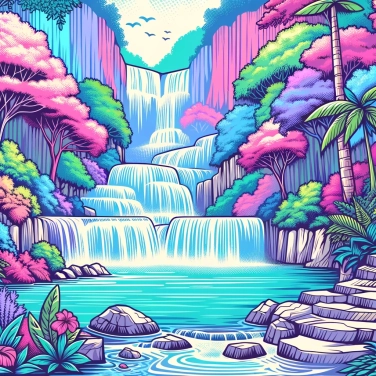Some waterfalls create natural pools at the base of their drop due to the movement of the water that digs and erodes the ground, thus forming depressions where water can accumulate and create basins.

When a waterfall cascades from a certain height, the energy of the water at impact is intense. This power gradually tears away chunks of rock at the base, thus carving out a natural pool. This phenomenon is called hydraulic erosion. Essentially, it's as if the water uses its repetitive waves like a hammer to break and gradually remove the rock, deepening a hollow beneath the fall. As this process progresses, the eroded rock fragments, known as sediments, are sometimes thrown to the sides or carried further away by the current, which further enlarges the natural pool created. Erosion also heavily depends on the type of rock and its resistance to the force of the water: some rocks withstand better, while others crumble quickly. That's why some waterfalls have perfectly shaped pools at their base while others do not.
Waterfalls that cascade over soft rocks like limestone or sandstone quickly wear away their base, carving out deep basins over time. In contrast, harder rocks like granite or basalt are more resistant, slowing down erosion and creating smaller or very slowly formed pools. The softer the rock, the faster the waterfall will carve out a beautiful natural pool. Those with a varied rock composition—alternating layers of hard and soft rocks—often create the most spectacular pools, thanks to the differences in erosion rates.
The height of a waterfall directly influences the energy with which the water strikes the ground: the higher it falls from, the faster it picks up speed. Upon reaching the bottom, it carries more sediments and erodes the rock more significantly, thus more easily forming a deep natural pool. Similarly, a large flow of water enhances this process: more water means more power, and therefore more erosion. As a result, tall and powerful waterfalls typically shape larger and deeper natural pools at their base. In contrast, small waterfalls with low flow often form less pronounced pools, or none at all.
The shape of the terrain around a waterfall greatly influences the formation of a natural pool. If you are in a narrow valley or a tight canyon, the water is channeled into a restricted space. It gains power and erodes more quickly at the base of the fall. In contrast, in flat or wide areas, the water spreads out more, its force decreases, and the basin forms more slowly or remains shallower. A naturally hollow or sloped ground also allows the water to accumulate more easily, gradually creating a true natural pool below.
The climate and the weather play a concrete role in the formation and maintenance of these natural pools at the foot of waterfalls. When it rains heavily, the increase in runoff accelerates the erosion of rocks, further deepening the basin at its base. Conversely, during periods of drought or freeze, the water decreases and the erosion capacity slows down. Cyclic freezing and thawing weaken and fracture the rocks, facilitating their detachment and the deepening of the basins. Some regions with contrasting seasons thus have more pronounced natural pools than places with a more stable or temperate climate. Finally, abundant vegetation due to wet weather stabilizes the soils around the waterfalls, sometimes limiting their erosion or altering their overall shape.
Natural pools at the foot of waterfalls are sometimes referred to as 'giant's kettles.' This vivid term comes from the circular and deep shape created by the swirling water laden with sediments and gravel.
The typical turquoise color of many natural pools generally comes from the refraction of light on fine mineral particles suspended in the water, such as calcium carbonate.
Some natural pools from waterfalls, especially those located in volcanic regions, can be naturally heated, thus forming true natural hot springs that are highly sought after for their relaxing properties.
Some natural pools formed by waterfalls host specific ecosystems, featuring rare species of fish and plants adapted to these particular environments.
Yes, these unique ecosystems can provide a suitable habitat for wildlife and flora adapted to specific conditions, such as regular water mixing, high humidity, and continuous oxygenation. You can find small species of fish, amphibians, insects, or aquatic plants that are specific to these particular environments, depending on the location and climate.
Safety largely depends on the depth, water flow, potential underwater currents, as well as the stability and type of substrate on the bottom. While most are pleasant for swimming, it is always recommended to exercise caution, as some natural pools may have dangerous currents or slippery terrain.
The permanent or temporary nature mainly depends on water flow, climate, and local geological characteristics. Some pools fill up only during certain times of the year, while others remain present throughout the year if natural conditions allow.
This clarity is due to the mechanical action of the waterfall, which strongly oxygenates the water and helps with continuous mixing. Furthermore, the flowing water from a waterfall is often less stagnant, thereby limiting the growth of algae and the accumulation of sediments, which contributes to keeping the water clear.
No, not all waterfalls necessarily create natural pools. This phenomenon depends on several factors such as the water flow, the height of the drop, the nature of the surrounding rocks, and local erosion. Some waterfalls flow directly onto a flat surface or onto very hard rocks, limiting the formation of a pool.

No one has answered this quiz yet, be the first!' :-)
Question 1/5